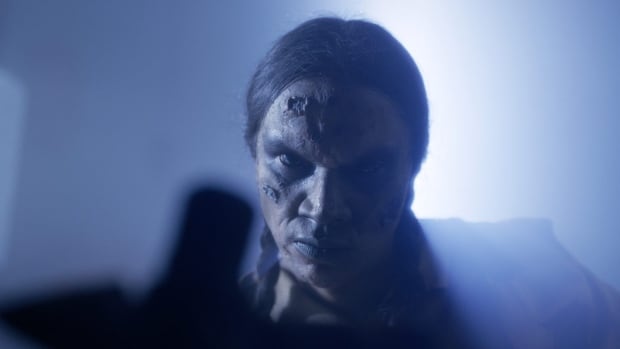While growing up in Siksika Nation, Trevor Solway would watch spooky TV shows such as Goosebumps, Tales from the Crypt and Are You Afraid of the Dark? in the evenings, before he and his cousins gathered around the kitchen to hear real-life Blackfoot legends told by their grandparents.
That pairing of culture and genre is the basis for the Calgary-based filmmaker’s APTNlumi series, Tales From The Rez. It combines the comedy-horror anthology format he loved in his youth and scary stories from his community, each updated and embedded with a lesson for younger generations.
“I think this is like a modern continuation of that tradition,” Solway told CBC News. “As Blackfoot filmmakers and storytellers, it’s our responsibility to come up with new stories.”
As Indigenous horror continues to cement itself as a rich subgenre, filmmakers such as Solway are reimagining old family ghost stories for the screen, melding genre and culture into something fresh, but still familiar to those who grew up with these stories and characters.
Like the radioactive monster films that Japan made after the nuclear attacks on Hiroshima and Nagasaki, or the American horror films of the 1970s that depicted the breakdown of traditional families, Solway says that the Indigenous horror subgenre draws from the community’s fears.
“I think for us, one of the scariest things that trumps all of those is colonial horror and the horrors that have been put upon us as Indigenous people,” he explained. During production of Tales From The Rez, he said the cast and crew held smudge ceremonies so as not to invite in the dark subject matter that the show depicts.
With Tales From The Rez, “there’s a lot of subthemes of toxic masculinity and alcoholism and all of these things that didn’t exist before contact,” he said. “And so, you know, there’s a layer of that to all the episodes and the struggles that we continue to deal with.”
During the first episode, for example, a devil walks into a bar — and Solway infuses the script with themes of toxic masculinity, addiction and colonialism. A later episode follows a trickster character who goes on a mischievous rampage.
Solway and producer Colin Van Loon pitched the series to Indigenous broadcaster APTN at a live pitch competition during the ImagiNATIVE Film and Media Arts Festival a few years ago. It was well-received by the audience, but it didn’t win.
“I think the really brilliant thing that Trevor was able to elevate through his writing was this idea of characters and narratives and the things that might have been happening that weren’t in the [original] story or the kind of urban legends that people told,” said Van Loon.
APTN recently renewed the series for a second season.
WATCH | The trailer for Tales From The Rez, a Blackfoot horror-comedy series:
Ghost hunting on Cape Breton Island
The duo aren’t the only ones repurposing urban legends. Dawn Wells, a Sydney, N.S.-based documentarian and ghost hunter, dives into the ghost stories and unexplained mysteries that haunt the Nova Scotia Island’s Mi’kmaq community in her series, Creepy Cape Breton.
“My grandmother would tell us ghost stories when we were younger. And it was just a family thing we all did,” said the Mi’kmaq filmmaker. Like Solway, she was fascinated by TV shows such as Unsolved Mysteries in her youth.
She thinks the show — coming from a Mi’kmaw filmmaker who was brought up surrounded by the community’s urban legend on a reserve — offers a unique perspective that isn’t usually found in the genre, mixing real-life UFO sightings and Bigfoot-like creatures with Mi’kmaq legends and smudging ceremonies.
“Traditionally the older generation, like my parents, were very superstitious. Even though we told ghost stories and everything, it actually kind of was a no-no to talk about the dead,” said Wells, which she attributed to a strong Catholic influence.
“It’s kind of strange because our culture is so wrapped in tradition and it’s so strongly connected to the earth and a lot of [spirituality].”
Day 69:13Tales from the Rez adapts Blackfoot ghost stories for the screen
Featured VideoWriter and director Trevor Solway, who grew up bingeing Tales from the Crypt and listening to his grandparents’ ghost stories around the kitchen table in the Siksika Nation, tells us about the making of the show and why Indigenous horror is taking off in a big way.
Jamesie Fournier, a Toronto-based Inuk horror writer, says his own interest in the genre was inspired by the stories that his mother told him as a child — bone-chilling tales that kept him and his brother from getting into trouble.
He believes there’s no better way to learn about a community than to learn what their fears are, pointing to a legend frequently told during his upbringing in Northwest Territories: the Qallupilluit, a creature that lives under the sea ice who drags down children playing too close to its cracks.
“In a lot of Indigenous cultures, we [have] the world that we see in front of us right now. But also behind that world there is a secondary one, a spiritual landscape that exists [where] all your actions have much more gravitas and the consequences are much more dark,” Fournier said.


